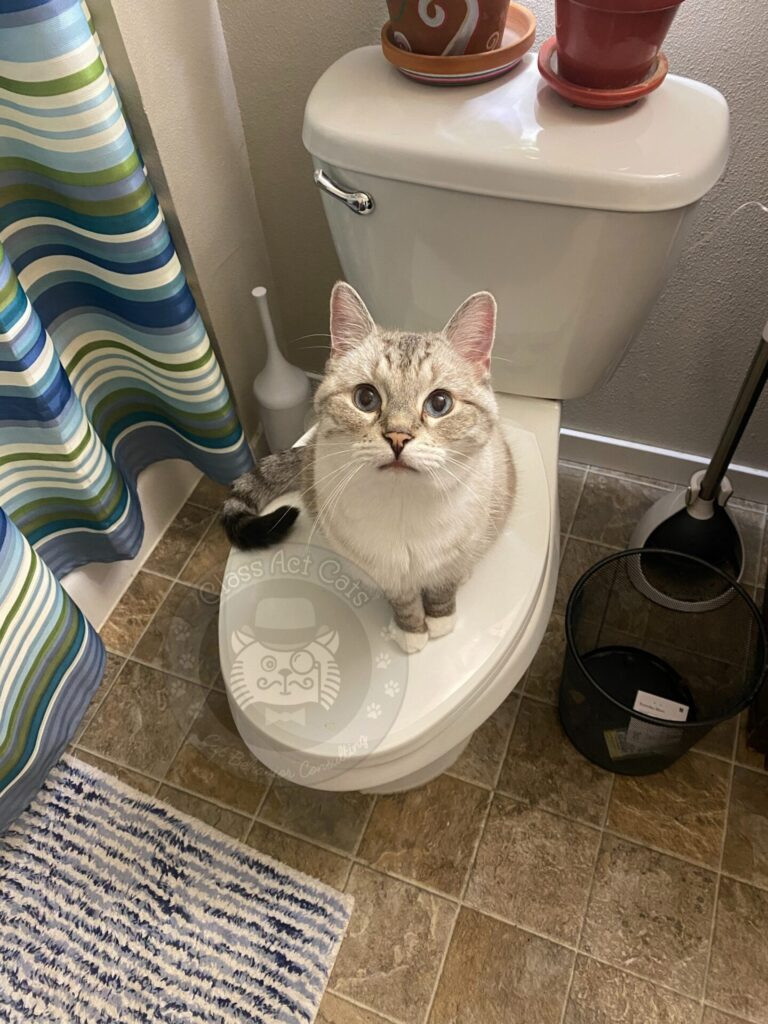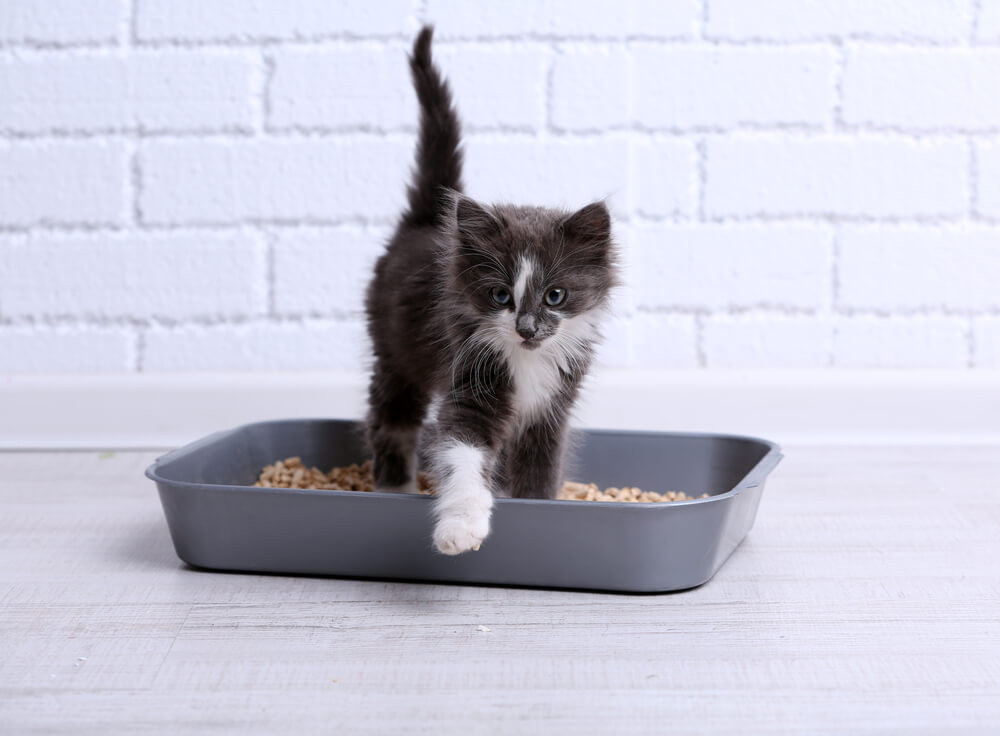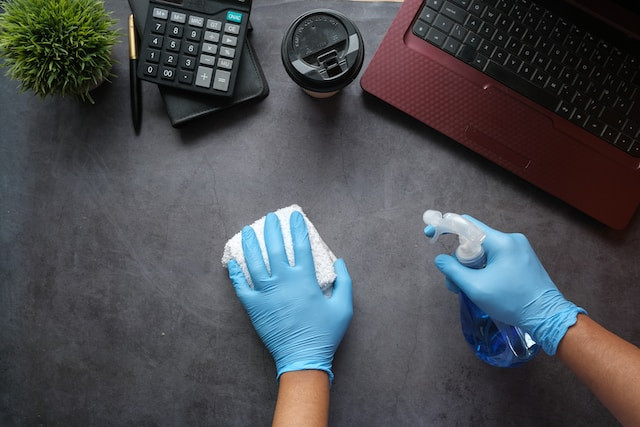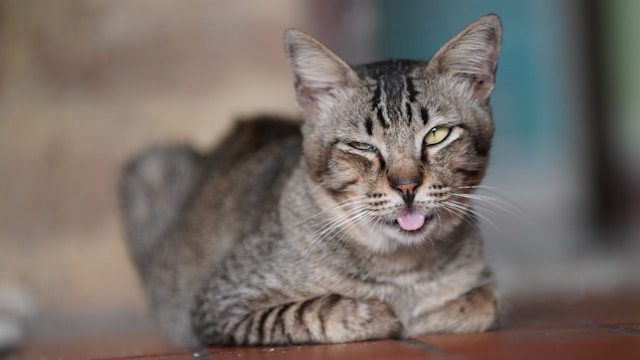Is cleaning cat pee with bleach effective? Discover safe and effective methods for eliminating cat urine odors and stains, ensuring a clean and healthy home with insights from solcat.net. Learn why enzymatic cleaners are superior and how to properly address accidents. Explore trusted resources for maintaining a fresh, cat-friendly environment.
1. Why Cat Pee Smells So Bad and Why It Lingers
Cat urine has a distinctive, pungent odor due to the presence of felinine, a sulfur-containing amino acid. This compound breaks down over time, releasing volatile organic compounds (VOCs) that contribute to the strong smell. The smell often returns after cleaning because of uric acid, another component of cat urine, which can linger in materials. Even trace amounts of uric acid can reactivate with moisture, causing the odor to resurface. According to research from the Cornell Feline Health Center, uric acid can persist in carpets and fabrics for years if not properly treated.
 Zoloft the cat sits on a closed toilet looking at the camera
Zoloft the cat sits on a closed toilet looking at the camera
Zoloft the cat sitting on a closed toilet, highlighting the challenges of cat care and cleaning.
1.1. The Role of Felinine and Uric Acid in Cat Urine Odor
Felinine is a unique amino acid found in cat urine, and its decomposition is a primary reason for the initial strong odor. Uric acid, however, is more persistent and does not easily break down with standard cleaning methods. This is why the smell can return, especially in humid conditions. The reactivation of uric acid is a common issue for cat owners, making thorough cleaning essential. Regular maintenance and appropriate cleaning products are crucial to eliminate these odors effectively, ensuring a fresh and pleasant environment for both you and your cat.
1.2. How Moisture Reactivates Lingering Cat Urine Odor
Moisture, such as humidity or even a damp cloth, can reactivate uric acid crystals left behind after cleaning. This reactivation releases the trapped odors, causing the cat pee smell to return. This is particularly problematic in carpets, upholstery, and porous materials where urine can seep deep down. Effective cleaning requires neutralizing uric acid with specialized enzymatic cleaners to prevent this recurrence. Maintaining a dry environment and ensuring thorough cleaning are key to keeping the odors at bay.
1.3. Why Cats Return to the Same Spot to Pee
Cats often return to the same spot to urinate because they can still detect the scent of their previous urine, even if humans cannot. Their sense of smell is much stronger, allowing them to identify residual uric acid and other compounds. This scent acts as a signal, indicating to the cat that the location is an appropriate place to urinate. To prevent repeat offenses, it’s crucial to eliminate all traces of urine odor using enzymatic cleaners. According to the American Animal Hospital Association (AAHA), these cleaners break down the uric acid, removing the scent that attracts cats back to the same spot.
2. Why Bleach Is a Bad Idea for Cleaning Cat Urine
Using bleach to clean cat urine is generally not recommended. While bleach can disinfect and lighten stains, it does not effectively break down the uric acid in cat urine that causes the odor. In fact, bleach can react with the ammonia in cat urine to produce toxic gases called chloramine. These gases are harmful to both humans and pets, causing respiratory irritation and other health problems. According to the ASPCA, mixing bleach with ammonia or urine is a hazardous combination that should be avoided.
 A grey kitten stepping out of a litter box.
A grey kitten stepping out of a litter box.
A gray kitten stepping out of a litter box, emphasizing the importance of proper hygiene and cleaning methods.
2.1. The Dangers of Mixing Bleach and Ammonia in Cat Urine
Mixing bleach with ammonia in cat urine creates a dangerous chemical reaction that produces toxic chloramine gas. Exposure to this gas can cause severe respiratory issues, including coughing, wheezing, and shortness of breath. In high concentrations, chloramine gas can be fatal. It’s essential to avoid using bleach on areas where cat urine is present to prevent this hazardous reaction. Always opt for safer, enzyme-based cleaners specifically designed to neutralize cat urine odors and stains.
2.2. How Bleach Can Damage Surfaces and Fabrics
Bleach is a harsh chemical that can damage or discolor many surfaces and fabrics. It can strip the color from carpets, upholstery, and clothing, leaving unsightly bleached spots. On hard surfaces like wood or tile, bleach can erode finishes and weaken the material over time. Using bleach on delicate materials can lead to irreversible damage, making it an unsuitable choice for cleaning cat urine. Always test cleaning products in an inconspicuous area first to ensure they do not cause damage.
2.3. Why Bleach Doesn’t Eliminate Cat Urine Odor Effectively
Bleach is primarily a disinfectant and whitening agent, not an odor neutralizer. While it may mask the smell of cat urine temporarily, it does not break down the uric acid and other compounds that cause the odor. As a result, the smell often returns as the bleach evaporates, leaving the underlying urine odor still present. For effective odor elimination, it’s essential to use enzymatic cleaners specifically formulated to break down the uric acid and neutralize the smell at its source.
3. Effective Products for Cleaning Cat Urine
To effectively clean cat urine, enzymatic cleaners are the best choice. These cleaners contain enzymes that break down the uric acid, proteins, and other components of cat urine, eliminating the odor at its source. Popular and effective enzymatic cleaners include Rocco & Roxie Stain & Odor Eliminator, Angry Orange Pet Odor Eliminator, and Nature’s Miracle Advanced Stain & Odor Remover. According to veterinarian Dr. Sarah Wooten, enzymatic cleaners are the most effective option because they target the specific compounds in cat urine that cause the odor.
3.1. The Science Behind Enzymatic Cleaners
Enzymatic cleaners work by using specific enzymes to target and break down the organic compounds in cat urine. These enzymes act as catalysts, accelerating the decomposition of uric acid, proteins, and other substances that cause odor and stains. Unlike সাধারণ cleaners that merely cover up the smell, enzymatic cleaners completely neutralize the source of the odor, providing a long-lasting solution. The enzymes continue to work until the organic matter is fully broken down, ensuring thorough and effective cleaning.
3.2. How to Choose the Right Enzymatic Cleaner
When choosing an enzymatic cleaner, look for products specifically formulated for cat urine. These cleaners contain a blend of enzymes designed to target the unique composition of cat urine. Ensure the product is safe for the surfaces you intend to clean and read customer reviews to gauge its effectiveness. Consider purchasing from reputable brands like Rocco & Roxie or Nature’s Miracle, known for their quality and reliability. Always follow the manufacturer’s instructions for best results.
3.3. The Role of Oxy Cleaners and Deodorizers
Oxy cleaners and deodorizers can be used as supplementary treatments after enzymatic cleaning. Oxy cleaners help to lift stains and brighten surfaces, while deodorizers provide a fresh scent to mask any remaining odors. However, these products should not be used as a substitute for enzymatic cleaners, as they do not break down the uric acid and other compounds that cause the odor. Instead, use them to enhance the cleaning process and leave your home smelling fresh and clean.
4. Step-by-Step Guide to Cleaning Cat Urine
Cleaning cat urine effectively requires a thorough and methodical approach. Here’s a step-by-step guide to help you eliminate both the stain and the odor:
4.1. General Cleaning Process
- Act Fast: The sooner you clean the urine, the better. Fresh urine is easier to remove than old, dried urine.
- Blot, Don’t Rub: Use paper towels or a clean cloth to blot up as much urine as possible. Avoid rubbing, as this can spread the stain and push the urine deeper into the material.
- Apply Enzymatic Cleaner: Saturate the affected area with an enzymatic cleaner. Follow the manufacturer’s instructions for application and dwell time.
- Wait and Let the Enzymes Work: Allow the cleaner to sit for the recommended time, typically 10-15 minutes. This allows the enzymes to break down the uric acid and other odor-causing compounds.
- Blot Again: Use a clean cloth or paper towels to blot up the remaining cleaner.
- Air Dry: Allow the area to air dry completely. Avoid using heat, as this can set the stain and odor.
- Repeat if Necessary: For stubborn stains or odors, repeat the process.
 A person cleaning cat pee with a squirt bottle.
A person cleaning cat pee with a squirt bottle.
A person using a squirt bottle to clean cat pee, illustrating the targeted approach needed for effective cleaning.
4.2. Cleaning Cat Urine from Furniture and Mattresses
- Remove Upholstery: If possible, remove the upholstery from the furniture or mattress.
- Treat the Stain: Apply an enzymatic cleaner to the affected area, ensuring it penetrates deep into the fabric and padding.
- Inject Cleaner (If Necessary): For mattresses or thick cushions, use a syringe or needle to inject the cleaner directly into the urine-soaked areas.
- Allow to Dwell: Let the cleaner sit for the recommended time.
- Blot and Dry: Blot up the excess cleaner and allow the furniture or mattress to air dry completely.
- Use a Waterproof Cover: Once dry, protect the furniture or mattress with a waterproof cover to prevent future accidents.
4.3. Cleaning Cat Urine from Flooring (Carpet, Wood, Rugs)
- Carpet:
- Blot up as much urine as possible.
- Apply an enzymatic cleaner to the affected area.
- Use a carpet cleaner with an enzymatic solution for deep cleaning.
- Allow to dry completely.
- Wood:
- Wipe up fresh urine immediately.
- Apply a wood-safe enzymatic cleaner.
- Let it sit for a short time, then wipe away.
- Dry the area thoroughly.
- Consider refinishing the wood if the stain and odor persist.
- Rugs:
- Washable Rugs: Machine wash with an enzymatic laundry detergent.
- Non-Washable Rugs: Spot clean with an enzymatic cleaner or hire a professional cleaner.
5. What to Do If Cleaning Attempts Fail
If your initial cleaning attempts are unsuccessful, don’t give up. Here are some troubleshooting tips:
5.1. Check the Cleaner and Method
- Expiration Date: Ensure your enzymatic cleaner is not expired. Enzymes degrade over time, reducing their effectiveness.
- Application: Make sure you are using enough cleaner and following the instructions properly.
- Surface Compatibility: Verify that the cleaner is safe for the surface you are cleaning.
5.2. Try a Different Product or Method
- Alternative Cleaners: If one enzymatic cleaner doesn’t work, try another brand. Different cleaners have different formulations and may be more effective on certain types of urine or surfaces.
- Deep Cleaning: Consider using a carpet cleaner or hiring a professional for deep cleaning.
5.3. Protect Your Stuff
- Waterproof Covers: Use waterproof covers on furniture, mattresses, and floors to prevent further damage.
- Reusable Pee Pads: Place reusable pee pads in areas where your cat frequently urinates outside the litter box.
5.4. Monitor Your Cat
- Video Camera: Set up a video camera to monitor your cat’s behavior and identify if they are returning to the same spot to urinate.
- Veterinary Checkup: Rule out any underlying medical issues that may be causing your cat to urinate outside the litter box.
6. Addressing the Underlying Cause of Inappropriate Urination
Cleaning up cat urine is only half the battle. It’s essential to address the underlying cause of why your cat is urinating outside the litter box. Common causes include:
6.1. Medical Issues
- Urinary Tract Infections (UTIs): UTIs can cause pain and discomfort, leading cats to associate the litter box with negative experiences.
- Kidney Disease: Kidney disease can increase urine production, making it difficult for cats to reach the litter box in time.
- Diabetes: Diabetes can also increase urine production, leading to accidents outside the litter box.
6.2. Behavioral Issues
- Stress and Anxiety: Stressful events, such as moving, new pets, or changes in the household, can cause cats to urinate outside the litter box.
- Litter Box Aversion: Cats may develop an aversion to the litter box if it is dirty, too small, or in an undesirable location.
- Territorial Marking: Cats may spray urine to mark their territory, especially in multi-cat households.
6.3. Litter Box Management
- Cleanliness: Keep the litter box clean by scooping it daily and changing the litter regularly.
- Litter Type: Experiment with different types of litter to find one your cat prefers.
- Location: Place the litter box in a quiet, accessible location away from food and water.
- Number of Litter Boxes: In multi-cat households, provide one litter box per cat plus one extra.
7. Additional Tips for a Cat-Friendly Home
Creating a cat-friendly environment can help prevent inappropriate urination and other behavioral issues. Here are some additional tips:
7.1. Provide Plenty of Vertical Space
Cats love to climb and perch, so provide plenty of vertical space with cat trees, shelves, and window perches. This allows them to feel safe and secure, reducing stress and anxiety.
 A cat with a silly face
A cat with a silly face
A cat with a silly face, emphasizing the need for humor and patience in pet care.
7.2. Offer Multiple Scratching Posts
Scratching is a natural behavior for cats, so provide multiple scratching posts in different locations. This will help protect your furniture and satisfy your cat’s urge to scratch.
7.3. Engage in Playtime
Regular playtime can help reduce stress and boredom, preventing behavioral issues. Use interactive toys like feather wands, laser pointers, and puzzle toys to keep your cat entertained.
7.4. Provide a Safe and Quiet Retreat
Cats need a safe and quiet place to retreat when they feel overwhelmed or stressed. Provide a comfortable bed or hideaway where your cat can relax and feel secure.
8. Real-Life Scenarios and Solutions
To further illustrate how to handle cat urine cleaning effectively, here are a few real-life scenarios and their corresponding solutions:
8.1. Scenario 1: Fresh Urine on the Carpet
Problem: You discover a fresh puddle of urine on your carpet.
Solution:
- Act Immediately: Blot up as much urine as possible with paper towels or a clean cloth.
- Apply Enzymatic Cleaner: Saturate the area with an enzymatic cleaner, following the manufacturer’s instructions.
- Wait and Blot: Allow the cleaner to sit for the recommended time, then blot up the excess.
- Air Dry: Let the area air dry completely.
- Repeat if Necessary: Check for any lingering odor and repeat the process if needed.
8.2. Scenario 2: Old Urine Stain on the Mattress
Problem: You find an old, dried urine stain on your mattress.
Solution:
- Rehydrate the Stain: Lightly dampen the stain with water to reactivate the urine.
- Apply Enzymatic Cleaner: Saturate the area with an enzymatic cleaner.
- Inject if Necessary: For deep stains, inject the cleaner directly into the mattress using a syringe.
- Wait and Blot: Allow the cleaner to sit for the recommended time, then blot up the excess.
- Air Dry: Let the mattress air dry completely, using a fan to speed up the process.
- Protect: Cover the mattress with a waterproof cover.
8.3. Scenario 3: Cat Spraying on Furniture
Problem: Your cat is spraying urine on your furniture to mark its territory.
Solution:
- Clean Affected Areas: Thoroughly clean all sprayed areas with an enzymatic cleaner.
- Identify the Cause: Determine the cause of the spraying (stress, territorial issues, etc.).
- Reduce Stress: Provide more vertical space, scratching posts, and playtime to reduce stress.
- Consult a Veterinarian or Behaviorist: If the spraying persists, consult with a veterinarian or cat behaviorist for further guidance.
9. The Role of Veterinary Professionals
Veterinary professionals play a crucial role in addressing cat urination issues. They can help diagnose and treat any underlying medical conditions that may be contributing to the problem. Additionally, they can provide guidance on behavioral modification techniques and recommend appropriate cleaning products. According to the American Association of Feline Practitioners (AAFP), regular veterinary checkups are essential for maintaining your cat’s health and preventing urination issues.
9.1. When to Consult a Veterinarian
Consult a veterinarian if your cat:
- Suddenly starts urinating outside the litter box.
- Is straining to urinate.
- Has blood in its urine.
- Is drinking more water than usual.
- Is showing signs of pain or discomfort.
9.2. The Importance of Early Diagnosis
Early diagnosis and treatment of medical conditions can prevent urination issues from becoming chronic. Veterinarians can perform urine tests, blood tests, and other diagnostic procedures to identify underlying health problems.
9.3. Behavioral Consultations
If medical issues have been ruled out, consider consulting with a cat behaviorist. A behaviorist can help you identify and address any behavioral issues that may be causing your cat to urinate outside the litter box. They can provide customized solutions and strategies to improve your cat’s behavior and overall well-being.
10. Why Choose Solcat.net for Cat Care Information?
At solcat.net, we are dedicated to providing accurate, reliable, and up-to-date information on all aspects of cat care. Our team of experts includes veterinarians, behaviorists, and experienced cat owners who are passionate about helping you provide the best possible care for your feline companions. We understand the challenges of cat ownership and strive to offer practical solutions and expert advice to help you create a happy and healthy home for your cats. Visit solcat.net for more valuable resources and tips on cat care. Our address is 950 Alaskan Way, Seattle, WA 98104, United States. You can also reach us at +1 (206) 386-4000.
10.1. Reliable and Up-to-Date Information
We pride ourselves on providing information that is both reliable and up-to-date. Our content is regularly reviewed and updated to reflect the latest research and best practices in cat care. You can trust solcat.net to provide accurate and trustworthy information.
10.2. Practical Solutions and Expert Advice
Our goal is to provide practical solutions and expert advice that you can use to improve your cat’s health and well-being. We offer step-by-step guides, troubleshooting tips, and expert insights to help you address common cat care challenges.
10.3. A Community of Cat Lovers
Join our community of cat lovers at solcat.net. Share your experiences, ask questions, and connect with other cat owners who are passionate about providing the best possible care for their feline companions. Together, we can create a world where all cats are happy, healthy, and loved.
FAQ: Cleaning Cat Pee Effectively
1. Can you clean cat pee with bleach?
No, bleach is not recommended for cleaning cat pee. It doesn’t effectively break down the uric acid that causes the odor and can create toxic gases when mixed with ammonia in urine.
2. What is the best way to clean cat urine?
The best way to clean cat urine is with an enzymatic cleaner. These cleaners break down the uric acid and other compounds that cause the odor.
3. How do enzymatic cleaners work?
Enzymatic cleaners contain enzymes that target and break down the organic compounds in cat urine, neutralizing the odor at its source.
4. Are there any safe alternatives to bleach for cleaning cat pee?
Yes, enzymatic cleaners are a safe and effective alternative to bleach. They are designed to neutralize cat urine odors without harmful chemicals.
5. How can I prevent my cat from peeing outside the litter box?
Ensure the litter box is clean, accessible, and in a quiet location. Rule out medical issues with a vet visit, and address any behavioral problems with a cat behaviorist.
6. What should I do if the cat urine smell returns after cleaning?
The cat urine smell may return if uric acid remains. Repeat cleaning with an enzymatic cleaner, ensuring thorough saturation and dwell time.
7. How do I clean cat urine from a mattress?
Remove bedding, apply an enzymatic cleaner directly to the stain, inject the cleaner for deep stains, and let it air dry completely. Protect the mattress with a waterproof cover.
8. Is it necessary to hire a professional to clean cat urine?
Hiring a professional may be necessary for severe cases or if you’re unable to eliminate the odor and stains on your own.
9. What are the signs of a urinary tract infection in cats?
Signs include frequent urination, straining to urinate, blood in the urine, and urinating outside the litter box. Consult a vet if these signs are observed.
10. How often should I clean my cat’s litter box?
The litter box should be scooped daily and completely emptied and cleaned at least once a month to maintain hygiene and encourage proper use.
By following this comprehensive guide, you can effectively clean cat urine and create a clean, healthy, and cat-friendly home. For more tips and information, visit solcat.net today. We are located at 950 Alaskan Way, Seattle, WA 98104, United States, and can be reached at +1 (206) 386-4000.

